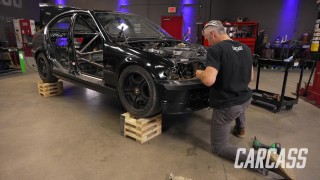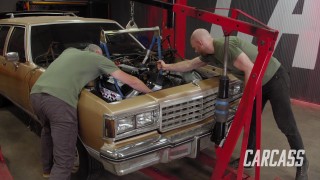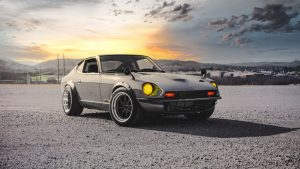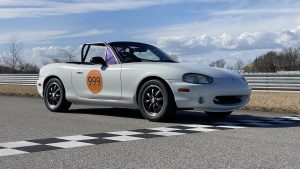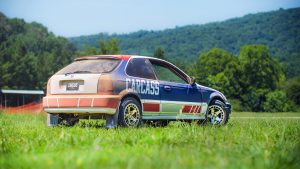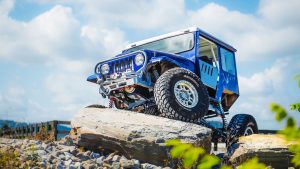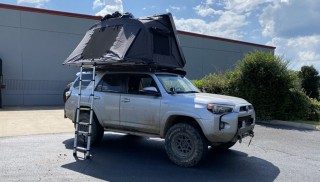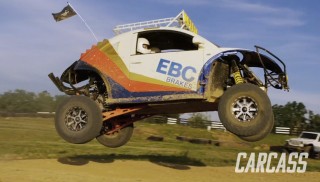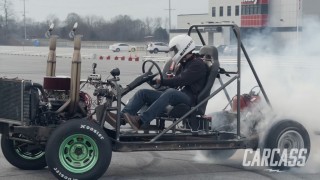More Square Body Tow Truck Episodes
Carcass Featured Projects
Carcass Builds
Want more content like this?
Join the PowerNation Email NewsletterParts Used In This Episode
Holley
B&M Transmission
Holley
Fuel Pump & Plug Wires
Matco Tools
MATCO Tools are the Official Tool Supplier to PowerNation
Matco Tools
Transmission Jack
The Industrial Depot
Tools, Hardware, Shop Supplies
WyoTech
Door Panels
Episode Transcript
(Jeremy)>> You're watching Powernation.
(Jimmy)>> Today on Carcass our junkyard tow truck breathes new life with a jump in power.
(Jeremy)>> Plus we repair even more rust. [ MUSIC ] [ tires squealing ] [ MUSIC ] [ engine revving ] [ MUSIC ]
(Jeremy)>> Let's get you all caught up on our junkyard tow truck that we're giving a new life through some fabrication and a little imagination.
(Jimmy)>> We had to dream big here with all the rust and lack of material left on the rear half of this frame. So we got straight to work cutting out all the cancer and fabbing up a new section of our design.
(Jeremy)>> With all that metal work out of the way we bolted up some new suspension parts to our dually axle and positioned it to where it would make this truck whole again.
(Jimmy)>> Awesome!
(Jeremy)>> We followed that up with the bed and towing assembly bringing back that vintage tow truck look that we fell in love with.
(Jimmy)>> That leads us to where we are today where this thing's gonna live again but with a little bit more horsepower.
(Jeremy)>> That's right, we've got about 350 horsepower to go underneath the hood of this thing. We're gonna back that up with a 700-R-4 4-speed automatic transmission, and the goal is to have this thing fired up by the end of the day.
(Jimmy)>> And we've heard this engine's rumble before. You may remember a project from last season that we called Frankenregal. We had a lot of fun doing burnouts, and we even drove that thing through the mud. So we figured we'd take the engine out of that project and put it in this one.
(Jeremy)>> And to finish off the front end we're gonna be doing a bunch of steering upgrades, and inside the cab that's gonna be a task of its own. The rusted out floorboards need a lot of attention, and I mean it's gonna be a ton of work.
(Jimmy)>> But before we fight that uphill battle let's do the fun stuff first and get the engine in this thing.
(Jeremy)>> That sounds good! [ drill buzzing ] [ MUSIC ]
(Jeremy)>> The engine in our tow truck is a 305. That's similar to the one that was in our autocross Camaro project from last year, and if you remember that vehicle when it was stock it didn't have a whole lot of pep in its step, and let's face it, this thing came out of a junkyard. We don't know if it's ever been taken care of. [ MUSIC ] Clear?
(Jimmy)>> Yep! Get that junk out of here.
(Jeremy)>> Now the motor came out of that pretty easy but now we've got to scavenge the motor out of Frankenregal, and you think that motor came out fast. This one's only going to take a couple of minutes. [ MUSIC ]
(Jimmy)>> We've had the 350 Chevy in our Frankenregal since the beginning, and we know exactly the conditions it's been operated in and how well it's been taken care of. [ MUSIC ] Now this skeleton of a vehicle has just been sitting in the warehouse collecting dust, and we know the engine runs and we know it runs well. So we have no problem dropping this guy in our patina'ed tow truck. [ MUSIC ]
(Jeremy)>> All clear?
(Jimmy)>> Yep. [ MUSIC ]
(Jeremy)>> Jimmy and I are Chevy fans and there's a good reason for that. We pulled the 305 out of the tow truck and we're gonna be replacing it with this 350, and we know that's going to work for a couple of reasons. The first is that GM didn't change the geometry of their V-8's from the mid '50's all the way into the '90's. Take our old tow truck for instance. This old square body could have come with a V-8 like a 305 or a 350, but it also could have come with a diesel option or a big block option. So knowing this GM setup their engine bay to handle all of those options. The other thing they did is they kept the bell housings on the transmissions the same. So if you had an automatic or a manual transmission it would bolt up to any engine that was offered in that vehicle. So like in our tow truck when we switched to an automatic transmission the only thing we have to change is the transmission itself. This makes swapping pretty much any GM power plant into any full size GM vehicle a breeze, and when they switched to the LS engine they even kept the bell housing the same. So you can run almost any GM transmission behind it. [ drill buzzing ]
(Jeremy)>> We're so close. It's just not lining up perfect. We're off by like a third of the bolt hole. We're so close.
(Jimmy)>> This engine didn't go in as easy as others have in the past. We were able to get one bolt through one of the mounts but the second was being stubborn. Our solution is to loosen the chassis side of the mount so we can feet the bolt through. With them all lined up we just snugged everything down. [ drill buzzing ]
(Jeremy)>> With our engine finally mounted it's time to install the B&M transmission that we picked up from Holley Performance. Now to get this installed we removed the old transmission crossmember, giving us plenty of room to maneuver. Our Matco Tools transmission jack makes easy work moving the 150 pound transmission, and with all the holes lined up we'll marry the trans to the engine.
(Jimmy)>> We have one more step left to do, and that's to install a compatible crossmember for this transmission. We picked up a universal crossmember from Summit Racing. We were able to use one of the existing bolt holes from the original crossmember, but we had to drill the remaining bolt hole out with a three-eighths drill bit, allowing us to snug up the crossmember.
(Jeremy)>> And since this one adjust to the width of the chassis we'll need to weld up the ends before calling this job done. [ MUSIC ]
(Jimmy)>> Up next, we get this rusty old tow truck safe for the road with some steering upgrades.
(Jeremy)>> Well the engine and trans are in the truck. I would love to fire this thing up but there's one issue. Our gas tank just hasn't come in yet.
(Jimmy)>> And also for the short time that this truck was running and driving there was a lot of play in the steering wheel, and that's actually coming from down here. All these steering components are so worn out they need to be replaced. So while the truck is still on the lift we thought we'd do it now.
(Jeremy)>> Yeah that idler arm's completely worn out.
(Jimmy)>> Yeah we've got to tear this stuff out. [ drill buzzing ]
(Jeremy)>> If you've been following this build you'll know that we've been dealing with a lot of rust on this vehicle, and the suspension and steering components are no exception. They all have castle nuts with cotter pins to promote safety and to make it impossible for these essential fasteners from coming loose. Well with all that rust it also makes it nearly impossible for us to remove them too.
(Jimmy)>> After poking and prodding, pulling and hammering, we had enough. So we used a punch to drive the pin half way and we cut the other end of the cotter pin off. Using an air impact we removed the castle nut, which essentially sheered the rest of the cotter pin off in the process. [ metal banging ]
(Jeremy)>> Now we need to stress one thing. The way that we took the nut off the tie rod end should only be done if you're replacing the tie rod end itself cause what happens is what's left of the cotter key gets rolled over onto the threads making it impossible to put a nut back on it, but since we're replacing all of the steering anyways, well that was the easiest way for us to get this out of the way.
(Jimmy)>> Continuing on with our steering disassembly we'll tackle the pitman arm next. This has a massive inch and five-sixteenths nut holding it on to the gear box. Then with a pitman arm puller we'll free it up.
(Jeremy)>> With that loose we can remove the steering linkage at the idler arm. That unbolts quickly, and with a ton of hefty hits it comes loose. This frees up the steering linkage allowing Jimmy and I to slide it out from behind the sway bar. It's just disgusting.
(Jimmy)>> The steering box is all worn out. So we're replacing it as well. We'll drain all the fluid in the power steering pump... [ air hissing ] ...before cutting the hoses, getting the pump out of the way for now. Next we can tackle the gearbox. We'll unhook both hoses. Then we can remove the pinch bolt attaching the rag joint to the input shaft. With it loose we'll use a pry bar to slide it off the shaft. Working from underneath the truck we can finally remove the four bolts attaching the steering box to the chassis. [ drill buzzing ]
(Jeremy)>> With our steering out of the way we're gonna tackle these worn out shocks. We're replacing them with a set of Bilsteins that we picked up from Summit Racing dot com. These are direct replacements. So they slip right into the existing mounts with a little help from a hammer and a pry bar. [ drill buzzing ]
(Jimmy)>> We just got done installing our shocks and it's time to move on to the rest of the steering linkage, but as we were under here we noticed that the sway bar bracket was bent out of shape, and upon closer inspection it's actually cracked. So we're gonna have to make a new one but that's a project for a little bit later. So for now we're just gonna take the sway bar out and move on to our steering linkage. This will be a little hairy coming out because one of the bolts is bent. A few taps of the hammer seems to get it somewhat straight, but a cutoff wheel makes this go a whole lot quicker. [ MUSIC ]
(Jeremy)>> I've been working on installing all our new steering pieces that we got from Rock Auto. Now the idea is to set this back in the truck as one assembly minus one piece. We're gonna put the pitman arm on the gearbox to make sure that it's clocked in the right direction, but here's a little tip when setting up your tie rod ends. All you've got to do is measure between the two points, and then transfer that measurement over to your new one. Then we'll just assemble everything and set it back in the truck, and that should get us pretty close, and at the end we'll just set it on the ground, send it out for an alignment, but the first thing I've got to do is make sure this one matches that one. [ MUSIC ]
(Jimmy)>> While Jeremy was working on the steering linkages I was installing the gearbox. [ MUSIC ]
(Jeremy)>> Alright you want to grab that side. [ MUSIC ]
(Jimmy)>> We'll first bolt up the idler arm. This will be kept hand tight until all the components are put together.
(Jeremy)>> Before we go any further we're gonna install the pitman arm. This is the only component that we'll tighten up for now. [ drill buzzing ]
(Jimmy)>> The linkage gets attached to the pitman arm with a castle nut, and then each knuckle receives each end of our linkage assembly.
(Jeremy)>> With everything loosely attached we can start tightening all the castle nuts. [ drill buzzing ]
(Jeremy)>> Lastly we'll add the cotter pins, and finally snug up the adjustment sleeves.
(Jimmy)>> With a little grease added to each ball joint our tires can go back on, resulting in a better handling tow truck when we take it for its first test drive.
(Jeremy)>> Coming up, we put the finishing touches on our engine and start hacking away at the rust in the cab. Next on Carcass!
(Jeremy)>> We're back to work on the powertrain of our 1977 C-30 tow truck. You may remember that our gas tank hadn't arrived yet. So we moved on to replacing the steering components on the front end. Well while you were in the break the big box arrived.
(Jimmy)>> That's right, but before we got to our fuel system we wanted to button up the front accessory drive. Things like the cooling fan, power steering pump, and the belts were all installed.
(Jeremy)>> We also threw in a brand new starter and some headers that we picked up from Summit Racing. Then we added some plug wires that we got from Holley Performance.
(Jimmy)>> A radiator got thrown in the mix getting it bolted in and plumbed up. All of this before we finally got to our fuel system. Our new tank from Summit Racing slips right in, and we hooked it up to the fuel pump.
(Jeremy)>> With the flick of a key we were able to crank up the engine and give it a couple pops of the throttle. [ engine revving ] [ MUSIC ]
(Jeremy)>> Well the motor runs great. So that takes care of the front. We fixed all the rust in the frame and that takes care of the back. I think it's about time we focus on the middle.
(Jimmy)>> If we can take care of the floors, and the crusty seat, and the cracked dash I think we'll be in pretty good shape.
(Jeremy)>> Yeah but I think before we get in here and start throwing a lot of sparks let's get the seat out of the way. [ drill buzzing ] [ MUSIC ]
(Jimmy)>> Check this out! [ MUSIC ]
(Jeremy)>> What'd you find?
(Jimmy)>> '51 Tennessee plate. That's old, that's cool! I love the profile of Tennessee, that's neat. Hang that up somewhere.
(Jeremy)>> Yeah put that in your shop. [ MUSIC ] [ shop vac humming ]
(Jeremy)>> Now there's getting around the fact that the floor inside this cab has seen its better days, and that's something Jimmy and I had noticed when we picked this thing up from the junkyard. Now we knew we'd have to replace some metal inside of the cab we just didn't know how much. Now after doing a little bit of digging and a lot of cleaning this is what we've come up with. We're gonna end up replacing the floor pans, the floor braces, the lower part of the kick panels, the inner and outer rockers on both the driver's and the passenger side of the truck, but as you can see here somebody has already replaced the outer rocker panel the wrong way. First of all they never did install the inner rocker panel, and secondly they never checked to see that the door would fit the opening. So when Jimmy and I picked this thing up from the junkyard the door would barely close and it wouldn't even latch, but what does that all mean? Well before we get to cutting out and replacing any metal inside this cab we've got to make sure that the door fits the opening and that it will close. Now our doors may look a little bit different than when we took them off at the beginning of this project. Well that's because we sent them out to our friends at Wyotech. An automotive vocational school where instructor Mike Fisher put his expertise to work doing some air brushing and adding some gold leaf, blending our logo and tag line onto the doors like it originally belonged there. [ ratchet clicking ] [ MUSIC ]
(Jeremy)>> Well that ain't gonna work. [ ratchet clicking ]
(Jeremy)>> Now that the doors fit and they close we're gonna add a brace to the opening to make sure that it stays in this position before we get on to cutting out the floors and the rockers. [ MUSIC ] [ welder crackling ] [ MUSIC ]
(Jeremy)>> Well now it's time to cut, and this could be pretty intimidating for a lot of you guys out there, but it's pretty simple if you follow a couple of easy steps. The first thing we need to know is where to cut. We picked up these extra-large floor pans from Brothers Trucks. Now they're 25 inches wide, 35.5 inches long. They stamped to match the original floor pans. Plus they're made out of thick gauge sheet steel. Now these should fit perfectly inside of our tow truck. The extra-large design will help us cut all of that rusty metal away and get us to some nice clean metal so we can weld these things in. Plus Brothers Trucks also sent us all the other sheet metal pieces so we can clean up our entire tow truck. Now the reason I pulled these out is because they're gonna tell us where to mark out our cut area. If we just line up the new pan over the old area it's replacing that will give us our outline. [ MUSIC ]
(Jimmy)>> And once we have an outline we'll come back and make a second mark about an inch and a half to two inches in from the first line. This will give us our cut line, and more importantly give us a flange to weld in the new floor pan. [ MUSIC ]
(Jeremy)>> After the break, piece by piece we put this rusty rig back together again.
(Jimmy)>> You're watching Carcass!
(Jeremy)>> We're back on the rust repair for the C-30 tow truck, but before we can install our floor pans that we got from Brothers Trucks there's a couple of things we need to take care of, like removing the old kick pan. [ MUSIC ] Well now that we have all the rusty metal cut out of the cab it's time to start replacing it with all the new parts that we got from Brothers Trucks. Now we're gonna do this is the reverse order that we took everything out. First we're gonna start by replacing the lower kick panel so it looks like it was installed from the factory. Then we'll grab the floor brace, set that in position, make sure it lines up with the cab mount. Then we're gonna bring in the big floor pan and set that in place. Now we're not gonna weld anything in until we know that everything fits. We'll use the original fender mounting hole to help locate the kick pan, clamping it into place for now. We'll also clamp in the floor brace before bringing in the floor pan for a test fit. [ metal clanging ] [ MUSIC ]
(Jeremy)>> Now our new floor pans we got from Brothers Trucks fit really well but that may not always be the case. So don't be afraid to grab a hammer, or a dolly, or even a screwdriver and help massage the new floor pan to match the old floor, but for us in our case these things fit perfectly. We're still not ready to weld these in quite yet cause we have to take care of the inner and the outer rocker panel on the side of the truck. [ MUSIC ] Yeah that fits pretty good. We'll take the inner rocker panel out for now so we can cut the previously installed outer rocker panel free. [ saw buzzing ]
(Jeremy)>> This will let us bring in our new outer rocker panel temporarily clamping it into place. [ MUSIC ] Alright well we're finally ready to start welding in our floors but there's a couple of different methods we could use, and there's a couple of different considerations to each one of those methods. First method being we could come in, lay the floor over the top of the old floor, and weld up this entire seam. The second method is we could come back, make a trace line, cut out that piece of metal and then butt the new floor to the old floor, weld that up solid, and that would give us a nice, clean finished look in the truck but we're not looking to restore this truck. All we're looking to do is get rid of the old rusty metal and replace it with some new stuff and make it nice and strong again. So there's one more method that we're gonna use. [ MUSIC ] A third method to welding in these panels involves punching or drilling out a series of holds in each of our new panels. Then with our welder setup to match our 18 gauge material we can weld in all our other parts starting with our kick panel. Each hole gets filled in completely, bonding the new metal to the existing sub-straight. This is a repetitive process but this is similar to how these panels were originally installed from the factory. [ welder crackling ] [ MUSIC ]
(Jeremy)>> This rosette style of welding is the method we've chosen to install all of our panels and our floor pan. All in all we have 250 rosette welds holding this new floor together, but we're not done with this cab yet. If you would like to follow along with this build check us out at Powernation TV dot com.
Show Full Transcript
(Jimmy)>> Today on Carcass our junkyard tow truck breathes new life with a jump in power.
(Jeremy)>> Plus we repair even more rust. [ MUSIC ] [ tires squealing ] [ MUSIC ] [ engine revving ] [ MUSIC ]
(Jeremy)>> Let's get you all caught up on our junkyard tow truck that we're giving a new life through some fabrication and a little imagination.
(Jimmy)>> We had to dream big here with all the rust and lack of material left on the rear half of this frame. So we got straight to work cutting out all the cancer and fabbing up a new section of our design.
(Jeremy)>> With all that metal work out of the way we bolted up some new suspension parts to our dually axle and positioned it to where it would make this truck whole again.
(Jimmy)>> Awesome!
(Jeremy)>> We followed that up with the bed and towing assembly bringing back that vintage tow truck look that we fell in love with.
(Jimmy)>> That leads us to where we are today where this thing's gonna live again but with a little bit more horsepower.
(Jeremy)>> That's right, we've got about 350 horsepower to go underneath the hood of this thing. We're gonna back that up with a 700-R-4 4-speed automatic transmission, and the goal is to have this thing fired up by the end of the day.
(Jimmy)>> And we've heard this engine's rumble before. You may remember a project from last season that we called Frankenregal. We had a lot of fun doing burnouts, and we even drove that thing through the mud. So we figured we'd take the engine out of that project and put it in this one.
(Jeremy)>> And to finish off the front end we're gonna be doing a bunch of steering upgrades, and inside the cab that's gonna be a task of its own. The rusted out floorboards need a lot of attention, and I mean it's gonna be a ton of work.
(Jimmy)>> But before we fight that uphill battle let's do the fun stuff first and get the engine in this thing.
(Jeremy)>> That sounds good! [ drill buzzing ] [ MUSIC ]
(Jeremy)>> The engine in our tow truck is a 305. That's similar to the one that was in our autocross Camaro project from last year, and if you remember that vehicle when it was stock it didn't have a whole lot of pep in its step, and let's face it, this thing came out of a junkyard. We don't know if it's ever been taken care of. [ MUSIC ] Clear?
(Jimmy)>> Yep! Get that junk out of here.
(Jeremy)>> Now the motor came out of that pretty easy but now we've got to scavenge the motor out of Frankenregal, and you think that motor came out fast. This one's only going to take a couple of minutes. [ MUSIC ]
(Jimmy)>> We've had the 350 Chevy in our Frankenregal since the beginning, and we know exactly the conditions it's been operated in and how well it's been taken care of. [ MUSIC ] Now this skeleton of a vehicle has just been sitting in the warehouse collecting dust, and we know the engine runs and we know it runs well. So we have no problem dropping this guy in our patina'ed tow truck. [ MUSIC ]
(Jeremy)>> All clear?
(Jimmy)>> Yep. [ MUSIC ]
(Jeremy)>> Jimmy and I are Chevy fans and there's a good reason for that. We pulled the 305 out of the tow truck and we're gonna be replacing it with this 350, and we know that's going to work for a couple of reasons. The first is that GM didn't change the geometry of their V-8's from the mid '50's all the way into the '90's. Take our old tow truck for instance. This old square body could have come with a V-8 like a 305 or a 350, but it also could have come with a diesel option or a big block option. So knowing this GM setup their engine bay to handle all of those options. The other thing they did is they kept the bell housings on the transmissions the same. So if you had an automatic or a manual transmission it would bolt up to any engine that was offered in that vehicle. So like in our tow truck when we switched to an automatic transmission the only thing we have to change is the transmission itself. This makes swapping pretty much any GM power plant into any full size GM vehicle a breeze, and when they switched to the LS engine they even kept the bell housing the same. So you can run almost any GM transmission behind it. [ drill buzzing ]
(Jeremy)>> We're so close. It's just not lining up perfect. We're off by like a third of the bolt hole. We're so close.
(Jimmy)>> This engine didn't go in as easy as others have in the past. We were able to get one bolt through one of the mounts but the second was being stubborn. Our solution is to loosen the chassis side of the mount so we can feet the bolt through. With them all lined up we just snugged everything down. [ drill buzzing ]
(Jeremy)>> With our engine finally mounted it's time to install the B&M transmission that we picked up from Holley Performance. Now to get this installed we removed the old transmission crossmember, giving us plenty of room to maneuver. Our Matco Tools transmission jack makes easy work moving the 150 pound transmission, and with all the holes lined up we'll marry the trans to the engine.
(Jimmy)>> We have one more step left to do, and that's to install a compatible crossmember for this transmission. We picked up a universal crossmember from Summit Racing. We were able to use one of the existing bolt holes from the original crossmember, but we had to drill the remaining bolt hole out with a three-eighths drill bit, allowing us to snug up the crossmember.
(Jeremy)>> And since this one adjust to the width of the chassis we'll need to weld up the ends before calling this job done. [ MUSIC ]
(Jimmy)>> Up next, we get this rusty old tow truck safe for the road with some steering upgrades.
(Jeremy)>> Well the engine and trans are in the truck. I would love to fire this thing up but there's one issue. Our gas tank just hasn't come in yet.
(Jimmy)>> And also for the short time that this truck was running and driving there was a lot of play in the steering wheel, and that's actually coming from down here. All these steering components are so worn out they need to be replaced. So while the truck is still on the lift we thought we'd do it now.
(Jeremy)>> Yeah that idler arm's completely worn out.
(Jimmy)>> Yeah we've got to tear this stuff out. [ drill buzzing ]
(Jeremy)>> If you've been following this build you'll know that we've been dealing with a lot of rust on this vehicle, and the suspension and steering components are no exception. They all have castle nuts with cotter pins to promote safety and to make it impossible for these essential fasteners from coming loose. Well with all that rust it also makes it nearly impossible for us to remove them too.
(Jimmy)>> After poking and prodding, pulling and hammering, we had enough. So we used a punch to drive the pin half way and we cut the other end of the cotter pin off. Using an air impact we removed the castle nut, which essentially sheered the rest of the cotter pin off in the process. [ metal banging ]
(Jeremy)>> Now we need to stress one thing. The way that we took the nut off the tie rod end should only be done if you're replacing the tie rod end itself cause what happens is what's left of the cotter key gets rolled over onto the threads making it impossible to put a nut back on it, but since we're replacing all of the steering anyways, well that was the easiest way for us to get this out of the way.
(Jimmy)>> Continuing on with our steering disassembly we'll tackle the pitman arm next. This has a massive inch and five-sixteenths nut holding it on to the gear box. Then with a pitman arm puller we'll free it up.
(Jeremy)>> With that loose we can remove the steering linkage at the idler arm. That unbolts quickly, and with a ton of hefty hits it comes loose. This frees up the steering linkage allowing Jimmy and I to slide it out from behind the sway bar. It's just disgusting.
(Jimmy)>> The steering box is all worn out. So we're replacing it as well. We'll drain all the fluid in the power steering pump... [ air hissing ] ...before cutting the hoses, getting the pump out of the way for now. Next we can tackle the gearbox. We'll unhook both hoses. Then we can remove the pinch bolt attaching the rag joint to the input shaft. With it loose we'll use a pry bar to slide it off the shaft. Working from underneath the truck we can finally remove the four bolts attaching the steering box to the chassis. [ drill buzzing ]
(Jeremy)>> With our steering out of the way we're gonna tackle these worn out shocks. We're replacing them with a set of Bilsteins that we picked up from Summit Racing dot com. These are direct replacements. So they slip right into the existing mounts with a little help from a hammer and a pry bar. [ drill buzzing ]
(Jimmy)>> We just got done installing our shocks and it's time to move on to the rest of the steering linkage, but as we were under here we noticed that the sway bar bracket was bent out of shape, and upon closer inspection it's actually cracked. So we're gonna have to make a new one but that's a project for a little bit later. So for now we're just gonna take the sway bar out and move on to our steering linkage. This will be a little hairy coming out because one of the bolts is bent. A few taps of the hammer seems to get it somewhat straight, but a cutoff wheel makes this go a whole lot quicker. [ MUSIC ]
(Jeremy)>> I've been working on installing all our new steering pieces that we got from Rock Auto. Now the idea is to set this back in the truck as one assembly minus one piece. We're gonna put the pitman arm on the gearbox to make sure that it's clocked in the right direction, but here's a little tip when setting up your tie rod ends. All you've got to do is measure between the two points, and then transfer that measurement over to your new one. Then we'll just assemble everything and set it back in the truck, and that should get us pretty close, and at the end we'll just set it on the ground, send it out for an alignment, but the first thing I've got to do is make sure this one matches that one. [ MUSIC ]
(Jimmy)>> While Jeremy was working on the steering linkages I was installing the gearbox. [ MUSIC ]
(Jeremy)>> Alright you want to grab that side. [ MUSIC ]
(Jimmy)>> We'll first bolt up the idler arm. This will be kept hand tight until all the components are put together.
(Jeremy)>> Before we go any further we're gonna install the pitman arm. This is the only component that we'll tighten up for now. [ drill buzzing ]
(Jimmy)>> The linkage gets attached to the pitman arm with a castle nut, and then each knuckle receives each end of our linkage assembly.
(Jeremy)>> With everything loosely attached we can start tightening all the castle nuts. [ drill buzzing ]
(Jeremy)>> Lastly we'll add the cotter pins, and finally snug up the adjustment sleeves.
(Jimmy)>> With a little grease added to each ball joint our tires can go back on, resulting in a better handling tow truck when we take it for its first test drive.
(Jeremy)>> Coming up, we put the finishing touches on our engine and start hacking away at the rust in the cab. Next on Carcass!
(Jeremy)>> We're back to work on the powertrain of our 1977 C-30 tow truck. You may remember that our gas tank hadn't arrived yet. So we moved on to replacing the steering components on the front end. Well while you were in the break the big box arrived.
(Jimmy)>> That's right, but before we got to our fuel system we wanted to button up the front accessory drive. Things like the cooling fan, power steering pump, and the belts were all installed.
(Jeremy)>> We also threw in a brand new starter and some headers that we picked up from Summit Racing. Then we added some plug wires that we got from Holley Performance.
(Jimmy)>> A radiator got thrown in the mix getting it bolted in and plumbed up. All of this before we finally got to our fuel system. Our new tank from Summit Racing slips right in, and we hooked it up to the fuel pump.
(Jeremy)>> With the flick of a key we were able to crank up the engine and give it a couple pops of the throttle. [ engine revving ] [ MUSIC ]
(Jeremy)>> Well the motor runs great. So that takes care of the front. We fixed all the rust in the frame and that takes care of the back. I think it's about time we focus on the middle.
(Jimmy)>> If we can take care of the floors, and the crusty seat, and the cracked dash I think we'll be in pretty good shape.
(Jeremy)>> Yeah but I think before we get in here and start throwing a lot of sparks let's get the seat out of the way. [ drill buzzing ] [ MUSIC ]
(Jimmy)>> Check this out! [ MUSIC ]
(Jeremy)>> What'd you find?
(Jimmy)>> '51 Tennessee plate. That's old, that's cool! I love the profile of Tennessee, that's neat. Hang that up somewhere.
(Jeremy)>> Yeah put that in your shop. [ MUSIC ] [ shop vac humming ]
(Jeremy)>> Now there's getting around the fact that the floor inside this cab has seen its better days, and that's something Jimmy and I had noticed when we picked this thing up from the junkyard. Now we knew we'd have to replace some metal inside of the cab we just didn't know how much. Now after doing a little bit of digging and a lot of cleaning this is what we've come up with. We're gonna end up replacing the floor pans, the floor braces, the lower part of the kick panels, the inner and outer rockers on both the driver's and the passenger side of the truck, but as you can see here somebody has already replaced the outer rocker panel the wrong way. First of all they never did install the inner rocker panel, and secondly they never checked to see that the door would fit the opening. So when Jimmy and I picked this thing up from the junkyard the door would barely close and it wouldn't even latch, but what does that all mean? Well before we get to cutting out and replacing any metal inside this cab we've got to make sure that the door fits the opening and that it will close. Now our doors may look a little bit different than when we took them off at the beginning of this project. Well that's because we sent them out to our friends at Wyotech. An automotive vocational school where instructor Mike Fisher put his expertise to work doing some air brushing and adding some gold leaf, blending our logo and tag line onto the doors like it originally belonged there. [ ratchet clicking ] [ MUSIC ]
(Jeremy)>> Well that ain't gonna work. [ ratchet clicking ]
(Jeremy)>> Now that the doors fit and they close we're gonna add a brace to the opening to make sure that it stays in this position before we get on to cutting out the floors and the rockers. [ MUSIC ] [ welder crackling ] [ MUSIC ]
(Jeremy)>> Well now it's time to cut, and this could be pretty intimidating for a lot of you guys out there, but it's pretty simple if you follow a couple of easy steps. The first thing we need to know is where to cut. We picked up these extra-large floor pans from Brothers Trucks. Now they're 25 inches wide, 35.5 inches long. They stamped to match the original floor pans. Plus they're made out of thick gauge sheet steel. Now these should fit perfectly inside of our tow truck. The extra-large design will help us cut all of that rusty metal away and get us to some nice clean metal so we can weld these things in. Plus Brothers Trucks also sent us all the other sheet metal pieces so we can clean up our entire tow truck. Now the reason I pulled these out is because they're gonna tell us where to mark out our cut area. If we just line up the new pan over the old area it's replacing that will give us our outline. [ MUSIC ]
(Jimmy)>> And once we have an outline we'll come back and make a second mark about an inch and a half to two inches in from the first line. This will give us our cut line, and more importantly give us a flange to weld in the new floor pan. [ MUSIC ]
(Jeremy)>> After the break, piece by piece we put this rusty rig back together again.
(Jimmy)>> You're watching Carcass!
(Jeremy)>> We're back on the rust repair for the C-30 tow truck, but before we can install our floor pans that we got from Brothers Trucks there's a couple of things we need to take care of, like removing the old kick pan. [ MUSIC ] Well now that we have all the rusty metal cut out of the cab it's time to start replacing it with all the new parts that we got from Brothers Trucks. Now we're gonna do this is the reverse order that we took everything out. First we're gonna start by replacing the lower kick panel so it looks like it was installed from the factory. Then we'll grab the floor brace, set that in position, make sure it lines up with the cab mount. Then we're gonna bring in the big floor pan and set that in place. Now we're not gonna weld anything in until we know that everything fits. We'll use the original fender mounting hole to help locate the kick pan, clamping it into place for now. We'll also clamp in the floor brace before bringing in the floor pan for a test fit. [ metal clanging ] [ MUSIC ]
(Jeremy)>> Now our new floor pans we got from Brothers Trucks fit really well but that may not always be the case. So don't be afraid to grab a hammer, or a dolly, or even a screwdriver and help massage the new floor pan to match the old floor, but for us in our case these things fit perfectly. We're still not ready to weld these in quite yet cause we have to take care of the inner and the outer rocker panel on the side of the truck. [ MUSIC ] Yeah that fits pretty good. We'll take the inner rocker panel out for now so we can cut the previously installed outer rocker panel free. [ saw buzzing ]
(Jeremy)>> This will let us bring in our new outer rocker panel temporarily clamping it into place. [ MUSIC ] Alright well we're finally ready to start welding in our floors but there's a couple of different methods we could use, and there's a couple of different considerations to each one of those methods. First method being we could come in, lay the floor over the top of the old floor, and weld up this entire seam. The second method is we could come back, make a trace line, cut out that piece of metal and then butt the new floor to the old floor, weld that up solid, and that would give us a nice, clean finished look in the truck but we're not looking to restore this truck. All we're looking to do is get rid of the old rusty metal and replace it with some new stuff and make it nice and strong again. So there's one more method that we're gonna use. [ MUSIC ] A third method to welding in these panels involves punching or drilling out a series of holds in each of our new panels. Then with our welder setup to match our 18 gauge material we can weld in all our other parts starting with our kick panel. Each hole gets filled in completely, bonding the new metal to the existing sub-straight. This is a repetitive process but this is similar to how these panels were originally installed from the factory. [ welder crackling ] [ MUSIC ]
(Jeremy)>> This rosette style of welding is the method we've chosen to install all of our panels and our floor pan. All in all we have 250 rosette welds holding this new floor together, but we're not done with this cab yet. If you would like to follow along with this build check us out at Powernation TV dot com.







